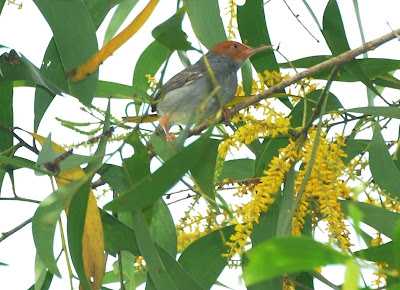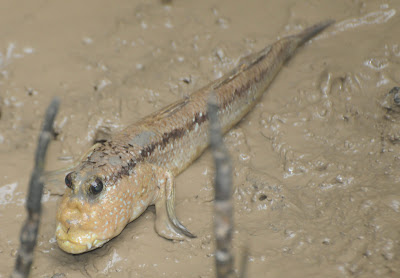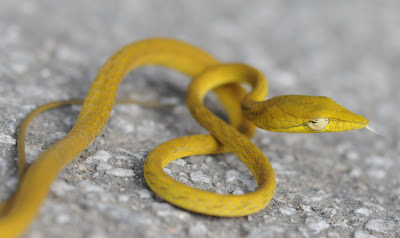January 2012 found us back in Sarawak, with Ryan safely returned to his parents as they waited for the arrival of his new brother Royce (to show how far behind this blog is, a third brother, Ryder, has now joined the family!).
Isai Raja (a relative of Eileen's, and a very nice fellow) may be retired, with a lovely home in Kuching, but I suspect he is still a farm boy at heart. He certainly takes a great deal of pride in his fruit orchard south of the city, and was as eager to show it off to us as we were to see it. On New Year's Day, Eileen and I joined him for an outing - here are Isai and Eileen admiring a jackfruit tree (Artocarpus heterophyllus) and its enormous, misshapen fruits.
I don't mind jackfruit, but it's not a great favourite of mine. Isai introduced me, though, to one of its cousins that I quite liked: terap or marang (Artocarpus odoratissimus), here carried by Isai's assistant.
A much more localised tree than jackfruit, which is now almost ubiquitous in tropical orchards, terap is native to Borneo and the nearby Philippine islands of Palawan and Mindanao. It has been described as having "a sweet custard-like flavour, each bit of fruit concealing a seed about the size of an olive pit". I would concur.
Fruit isn't the only thing the orchard produces. Ponds stocked with fish are a common sight in rural Malaysia, and Isai's property was no exception.
Catfish are particularly popular here. This is one of the so-called walking catfish (Clarias sp.). There are native species in Borneo, but this is more likely the commonly-grown Clarias batrachus, a native of Java that has become a serious invasive in many parts of the world including North America (it gets its common name from its ability to travel surprisingly long distances on land as it journeys from pond to pond).
Where there are ponds, especially ponds whose owners haven't cleared the emergent vegetation around their edges, there are likely to be dragonflies. Orthetrum sabina was common around Isai's ponds (as it seems to be almost everywhere in Malaysia in open country with standing water).
Here are a pair "in wheel", the peculiarly complicated mating posture of dragonflies and damselflies. For a thorough and engaging article about the unique courtship of odonates, and the evolutionary reasons for it, read this 2006 article from National Geographic.
Orthetrum sabina is a handsome creature, but one I had seen and photographed many times before (as weary readers of this blog may be well aware). More exciting for me were two species I was encountering for the first time. Meet Ictinogomphus decoratus, a large and striking insect and the most obvious of Malaysia's Gomphidae, a family of dragonflies with fully separated eyes and, usually, swollen clubs at the end of their abdomens.
On a grassy slope above the ponds an insect I found an insect that I took, at first, for some sort of wasp or fly. It turned out to be a female Nannophya pygmaea (males are mostly bright red). At 15mm in length, pygmaea is certainly the tiniest dragonfly in Malaysia, and it is often listed as the smallest in the world. I was delighted to find it.
For comparison, this really is a fly, and a fairly spectacular one at that.
Also quite spectacular, in a quiet way, was this dainty spray of white orchids (can anybody out there identify them?) [Sean L did: Dendrobium crumenatum. Thanks!]
Our tour over, we relaxed in the shade for a picnic mean of Isai's fruits...
…including the well-chewed remains of a terap, and a batch of mangosteens - my own favourites.
Finally, a brief stop in a small town on the way home….
Where a pair of Pacific Swallows (Hirundo tahitica) guarded their nest under the wooden overhang.
Monday, July 29, 2013
West Malaysia: Kuala Selangor
Ryan has become a real wetland enthusiast, and a wetland with mudskippers is his idea of heaven. The mangrove boardwalk at the Malaysian Nature Society's Kuala Selangor Nature Park, on the west coast of the Peninsula, therefore became a "must" last stop on our 2011 spin through New Zealand and Peninsular Malaysia.
We had only a few days before Eileen and I had to take Ryan back to his parents in Kuching (in time for his New Year's Eve birthday), but our friends Chips and Shirley arranged things for us. On December 28 Ryan and I headed down from Kuala Lumpur to the coast with Chips, Shirley, Terry Law and young Cheok Chun Chong, home on vacation from his high school in Beijing and eager to record the day on video for a film-making project. Ryan immediately adopted him as a temporary big brother.
As we headed through the coastal forest to the boardwalk, we were greeted by a primate reception committee. Kuala Selangor is home to two very different monkeys. Long-tailed Macaques (Macaca fascicularis) are aggressive omnivores (and inveterate garbage-raiders), in trees or on the ground. Many people heartily dislike them - probably because they behave uncomfortably like our own pugnacious and opportunistic species, and we can't have that.
An altogether different animal is the Silvered Langur or Leaf-Monkey (Trachypithecus cristatus). It is a committed vegetarian, living largely on leaves though it will also eat fruit, seeds, flowers and other plant parts. It has a specially modified stomach to help it handle the load of cellulose in its diet. Unlike the macaque it spends comparatively little time on the ground (and you are less likely to be bitten by one).
One of the most attractive trees of the mangrove forest is Mangrove Apple or Perapat (Sonneratia alba). It can tolerate high levels of salt in the soil - pretty much a requirement for any plant that wants to survive here. Like the black mangroves (Avicennia) it sends up aerial roots - pneumatophores - that project above the soil like miniature obelisks and allow the plant to take up oxygen from the air. According to a helpful sign on the path, its flowers open at dusk, smell of soured milk, last only one night and are pollinated by fruit bats.
… or a strikingly-plumed caterpillar making short work of a mangrove leaf.
Butterflies along the way included a Blue Glassy Tiger (Ideopsis vulgaris macrina)...
…and its considerably rarer cousin, the Malay or Mangrove Tiger (Danaus affinis malayanus), a specialty of the area. Mangrove Tigers are found in numbers only at two sites in Malaysia, one of which is Kuala Selangor. For North Americans, the tigers are cousins of the familiar Monarch (Danaus plexippus), and like the monarch they lay their eggs on various species of milkweed. The Mangrove Tiger (which looks rather like a rather gaudy Monarch) is but one of about 30 subspecies of D. affinis ranging from Thailand to Australia, some much more black-and-white than this one.
There were, of course, birds, too, but we had arrived a bit too late in the morning for their main rush of activity. Ashy Tailorbirds (Orthotomus ruficeps), though, keep active pretty much throughout the day.
A wooden observation tower near the head of the boardwalk gave a good view both of the surrounding country and of any birds sitting in the treetops.There were, of course, birds, too, but we had arrived a bit too late in the morning for their main rush of activity. Ashy Tailorbirds (Orthotomus ruficeps), though, keep active pretty much throughout the day.
Here is a Brahminy Kite (Haliastur indus), the commonest raptor of the mangroves.
In the distance we spotted two Lesser Adjutants (Leptotilos javanicus), huge, rather forbidding-looking storks with nearly bare heads and necks and massive bills. It is a species in decline: there are probably only about 500 birds in the whole of Malaysia.
The Dollarbird (Eurystomus orientalis) is a handsome creature, but it's not always easy to get eye-level with one.
Back at ground level, we set out along the boardwalk, our eyes peeled for mudskippers. This bright little fungus was sprouting directly from the boardwalk's timbers.
No mangrove flat in the world is complete without fiddler crabs (Uca spp.), the males attempting to wave over potential mates (or wave away rivals) with their oversized right claws. There are 101 recognised species worldwide - for information and photographs of many of them see here.
Far less obvious are these mangrove crabs (genus Perisesarma, I think - a genus whose members, according to Wikipedia, "eat nearly anything they can and will try to eat anything that doesn't threaten them — including pencils and other objects dropped on the forest floor").
Even less obvious are tiny hermit crabs huddled beneath their snail-shell homes. The shells former owner may be the Truncated Mangrove Snail or balitong (Cerithidea decollata), a local delicacy. The snails retreat to the mangrove trunks when the tide comes in and return to the mud once the waters ebb, a migratory behaviour that has been studied in East Africa.
This shell carries its crustaceans on the outside. Rock barnacles need somewhere solid to attach themselves, and there aren't a lot of rocks out here.
Long-tailed Macaques are also called Crab-eating Macaques, and the remains of these horseshoe crabs may be evidence of their handiwork. Of course horseshoe crabs aren't really crabs or even crustaceans, but let's not be picky.
Three of the world's four horseshoe crab species occur in Malaysia (the other one, Limulus polyphemus, lives on the eastern seaboard of North America). For a detailed article on horseshoe crabs in Malaysia see here. Based on the large size of the spines bordering the opisthoma, or abdomen, and the smooth leading edge of the prosoma (the big piece at the front) these are Coastal Horseshoe Crabs (Tachypleus gigas).
One of the mangrove flat's genuine crustaceans rarely shows itself. It reveals its presence, however, with these strange objects, rather like miniature mud volcanoes (some of them aren't so miniature - they can be three metres tall!). They are the work of the Mud Lobster (Thalassina anomala), an important (if rarely seen) inhabitant of the mangrove ecosystem whose burrows aerate the soil, recycle organic debris and facilitate the growth of a number of tree species. Also, they spur visitors to ask useful questions, like "What the heck is that?"
These are Giant Mudskippers (Periophthalmodon schlosseri), a species we missed on our last mangrove walk in Singapore. That broad black stripe along the side is a give-away (though not every individual is as strongly marked as this one).
As their name suggests, they are one of the largest mudskippers in the world, reaching an impressive 27 cm. They are active hunters, feeding mostly on crabs but even preying on smaller mudskippers - which may explain why we didn't see any other species around!
I think mudskippers appeal to kids (Ryan included) because they look so much like frogs gone wrong. It's the googly eyes, of course. Anyway, that's why they appeal to me - though the zoologist in me can't help but look at these highly-derived, modern fishes (there are no known fossils, apparently) as they peer above the surface or hop about on the flats without harking back a few hundred million years to the utterly different fishes, on a lineage quite different from the one that has led to the mudskippers, whose lineal descendants we are. When I delight in mudskippers, am I responding to a sympathy between one fish out of water and another?
Labels:
Malaysia,
West Malaysia
Location:
Kuala Selangor, Selangor, Malaysia
West Malaysia: FRIM
My patient readers (should any remain) will have to forgive me yet again for falling so far behind in my blog entries. Unfortunately I managed to follow an extremely busy few months of book-writing and conference-attending with a bout of illness that has lasted almost three months. So please excuse me, and let's head back to the increasingly dim past of December 2011. To paraphrase a TV show of my youth: return with me now to those thrilling days of yesteryear - The Wandering Naturalist writes again!




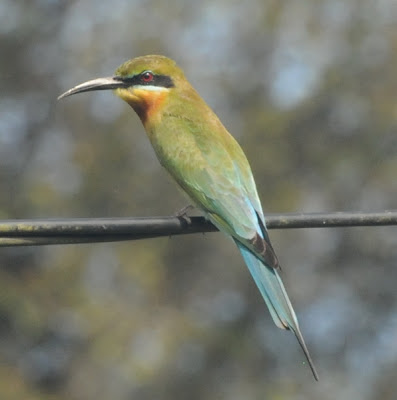

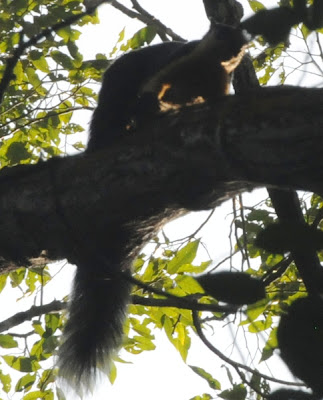

I'm not sure what this colourful little caterpillar is going to grow up to be, but its bright markings and apparent disinterest in hiding suggest it has some toxic defences at hand. Best to leave it alone!
Compare this Neurothemis fluctuans with the one I showed you earlier. The extent of dark on the wings is pretty variable in this species, and in this individual it barely reaches the inner edge of the pterostigma (the little red bar on the leading edge of each wing).
This is an immature male, his wing patches pale amber instead of russet brown. In this species - but not in some other members of the genus - the female's wings are largely clear.
More common dragonflies: the ubiquitous Orthetrum sabina…
And two red-bodied species (there are several others, just to make things more difficult for dragonfly-identifiers): Orthetrum testaceum (above) and the psychedelically-glowing Trithemis aurora (below).
Butterflies along the road edge included one of the more identifiable pierids, the Chocolate Albatross (Appias lyncida). I'm still not are why these butterflies are called albatrosses, unless the black edging on the wings reminded someone of the wing patterns on the birds (for albatrosses with feathers, see my trip to Kaikoura in New Zealand).
The Common Lime (Papilio demoleus) is one of the more ubiquitous and successful Malaysian swallowtails. It gets its name not from its colour (or, presumably, flavour) but because its caterpillars are citrus eaters. The species ranges from the Persian Gulf to Australia and the Pacific. It is a recent arrival in Borneo, where it is now common, and an introduced pest in the Caribbean. There is a good article on the species in Wikipedia.
More butterflies, all nymphalids: a Malay Cruiser (Vindula dejone) (top), a Malay Viscount (Tanaecia pelea) (middle), and two photos of a rather tattered Peacock Pansy (Junonia almana) (bottom).
While all these little critters are quite capable of keeping me happy, their effect on a boy just shy of five (as Ryan was at the time) may be less exciting. For real small-boy thrills, though, nothing beats a snake. When a villager (who realised what we were about) walked up to us with this creature draped over a stick, it was the high point of the day.
His find was an Oriental Whip Snake (Ahaetulla prasina), coloured mustard-yellow rather than the almost shocking green of many individuals. For Ryan any snake is exciting (though as this one is mildly venomous I didn't let him get too close), but for me tho species is especially fascinating as a remarkable example of convergent evolution.
It's a ringer for a number of unrelated vine snakes (Oxybelis, etc) from Central and South America. Like them it is a tree-dweller, with a long, thin body capable of extending itself into space for a remarkable distance and a peculiar pointed snout. Pet fanciers, who have unfortunately taken to both the Asian and American snakes, frequently mix them up (as a quick internet search will tell you).
So both Ryan and his Grandpa had something to be excited about! The snake was released, by the way (and I hope it stayed that way), and the day ended, I presume, happily for all.

From Singapore, Eileen and I took Ryan on a trip to West Malaysia before heading back to Sarawak. Nature watching was not our primary purpose, but our friends Chips and Shirleyour good friends Ng Chih Piew ("Chips") and his wife Shirley Lim did arrange a couple of outings for Ryan from Kuala Lumpur in the company of Terry Law, a local naturalist.

The first, on December 26, visited the grounds of FRIM, the Forest Research Institute of Malaysia, on the edge of the city. The ponds and forest edge on the FRIM grounds are good places for a young naturalist to investigate.
We start small, with ants negotiating their way around a flower head.
Also on the small side: a fly, stretching out one wing in some sort of display.
We'll keep with insects for a while, but move on to a few larger ones. Palm Darts (Telicota sp.) are a group of common but (for me at least) difficult-to-identify skippers. These are separate individuals; perhaps separate species, for all I know.
Also in the common-but-difficult category are the grass yellows (Eurema sp.). There are nine species in Malaysia. This one appears to be a Chocolate Grass Yellow (Eurema sari sodalis), based on the shape of the brown patch at the tip of the forewing.
And here is the unfortunately-named Nigger (Orsotriaenia medus). Can't someone come up with an alternate English name for this butterfly?
I'm easily distracted by the local odonates (dragonflies and damselflies, for the non-initiated). I think this damselfly is a female Violet Sprite (Archibasis viola), but then again, maybe it isn't.
Neurothemis fluctuans, the Common Parasol, is very common indeed in Peninsular Malaysia. This is an adult male.
Also on the small side: a fly, stretching out one wing in some sort of display.
We'll keep with insects for a while, but move on to a few larger ones. Palm Darts (Telicota sp.) are a group of common but (for me at least) difficult-to-identify skippers. These are separate individuals; perhaps separate species, for all I know.
Also in the common-but-difficult category are the grass yellows (Eurema sp.). There are nine species in Malaysia. This one appears to be a Chocolate Grass Yellow (Eurema sari sodalis), based on the shape of the brown patch at the tip of the forewing.
And here is the unfortunately-named Nigger (Orsotriaenia medus). Can't someone come up with an alternate English name for this butterfly?
I'm easily distracted by the local odonates (dragonflies and damselflies, for the non-initiated). I think this damselfly is a female Violet Sprite (Archibasis viola), but then again, maybe it isn't.
Neurothemis fluctuans, the Common Parasol, is very common indeed in Peninsular Malaysia. This is an adult male.



There are obvious and colourful birds - Blue-tailed Bee-Eaters (Merops philippinus) perched gracefully on wires or hawking overhead for prey (including, no doubt, some of the insects we have been looking at)...

..and a Black-naped Oriole (Oriolus chinensis) peeking out from behind the fronds of a palm.

Overhead we spot a Black Giant Squirrel (Ratufa bicolor) scampering along a tree limb, silhouetted againt the sky…

…and, picking its way down a trunk, a young Water Monitor (Varanus salvator).
From the FRIM grounds we moved on to the environs of a nearby orang asli community (orang asli is a generic term for the indigenous people of Peninsular Malaysia).
We followed a road through second-growth scrub dotted with rubber trees scarred with the tappers' cuts.
The road paralleled a small, sandy-bottomed stream. This little fish is almost certainly a member of the Cyprinidae, and is probably a barb of some sort - but that's as far as I can go.
By now we were in the heat of the day, when insect-watching usually takes over from birding as a strolling naturalist's activity of choice. From the FRIM grounds we moved on to the environs of a nearby orang asli community (orang asli is a generic term for the indigenous people of Peninsular Malaysia).
We followed a road through second-growth scrub dotted with rubber trees scarred with the tappers' cuts.
The road paralleled a small, sandy-bottomed stream. This little fish is almost certainly a member of the Cyprinidae, and is probably a barb of some sort - but that's as far as I can go.
I'm not sure what this colourful little caterpillar is going to grow up to be, but its bright markings and apparent disinterest in hiding suggest it has some toxic defences at hand. Best to leave it alone!
Compare this Neurothemis fluctuans with the one I showed you earlier. The extent of dark on the wings is pretty variable in this species, and in this individual it barely reaches the inner edge of the pterostigma (the little red bar on the leading edge of each wing).
This is an immature male, his wing patches pale amber instead of russet brown. In this species - but not in some other members of the genus - the female's wings are largely clear.
More common dragonflies: the ubiquitous Orthetrum sabina…
And two red-bodied species (there are several others, just to make things more difficult for dragonfly-identifiers): Orthetrum testaceum (above) and the psychedelically-glowing Trithemis aurora (below).
Butterflies along the road edge included one of the more identifiable pierids, the Chocolate Albatross (Appias lyncida). I'm still not are why these butterflies are called albatrosses, unless the black edging on the wings reminded someone of the wing patterns on the birds (for albatrosses with feathers, see my trip to Kaikoura in New Zealand).
The Common Lime (Papilio demoleus) is one of the more ubiquitous and successful Malaysian swallowtails. It gets its name not from its colour (or, presumably, flavour) but because its caterpillars are citrus eaters. The species ranges from the Persian Gulf to Australia and the Pacific. It is a recent arrival in Borneo, where it is now common, and an introduced pest in the Caribbean. There is a good article on the species in Wikipedia.
More butterflies, all nymphalids: a Malay Cruiser (Vindula dejone) (top), a Malay Viscount (Tanaecia pelea) (middle), and two photos of a rather tattered Peacock Pansy (Junonia almana) (bottom).
While all these little critters are quite capable of keeping me happy, their effect on a boy just shy of five (as Ryan was at the time) may be less exciting. For real small-boy thrills, though, nothing beats a snake. When a villager (who realised what we were about) walked up to us with this creature draped over a stick, it was the high point of the day.
His find was an Oriental Whip Snake (Ahaetulla prasina), coloured mustard-yellow rather than the almost shocking green of many individuals. For Ryan any snake is exciting (though as this one is mildly venomous I didn't let him get too close), but for me tho species is especially fascinating as a remarkable example of convergent evolution.
It's a ringer for a number of unrelated vine snakes (Oxybelis, etc) from Central and South America. Like them it is a tree-dweller, with a long, thin body capable of extending itself into space for a remarkable distance and a peculiar pointed snout. Pet fanciers, who have unfortunately taken to both the Asian and American snakes, frequently mix them up (as a quick internet search will tell you).
So both Ryan and his Grandpa had something to be excited about! The snake was released, by the way (and I hope it stayed that way), and the day ended, I presume, happily for all.
Labels:
Malaysia,
West Malaysia
Subscribe to:
Posts (Atom)




























